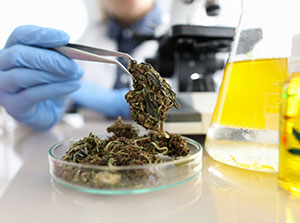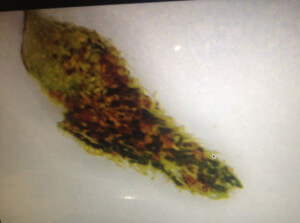Microscopic Testing Marijuana in New Jersey
 The first step that is taken at the laboratory by the State’s chemist is to evaluate the suspected marijuana with microscopy. This process involves using a single or binocular microscope.
The first step that is taken at the laboratory by the State’s chemist is to evaluate the suspected marijuana with microscopy. This process involves using a single or binocular microscope.
The microscope may be digital or may be connected to a computer, in order to enhance the image. [You can see Kevin Leckerman using a binocular microscope for evaluating a suspected marijuana sample.] →
During the microscopic evaluation, the chemist is looking for a specific type of hair that grows on the marijuana plant. This hair is called a cystolithic hair. It resembles a cat’s claw in shape and translucency.
Even with a powerful, state-of-the-art microscope, it is difficult to properly identify a cystolithic hair. This is because the marijuana plant has different types of hairs that look similar to the cystolithic hair.
The next step is to look for a “glandular hair.” This glandular hair resides on the opposite side of the plant leaf from the cystolithic hair. The glandular hair resembles a mushroom.
Identification of the cystolithic hair and glandular hair does not determine that the plant is conclusively marijuana. There are a number of different plants that also have these hairs like the marijuana plant. A confirmatory test must be conducted in order to positively identify a sample as marijuana.

Questions arise concerning how proficient the chemist is in making a subjective identification of the hairs of the marijuana plant. Did the lab do blind testing of the chemist to determine the percentage of correct identifications that the chemist made during any training period? Does the lab continue to test the chemist to see if that person can still make correct identifications of marijuana? Or is the chemist left unchecked to make these serious determinations?
The next step that the New Jersey state chemist takes is to perform a color test, known as the Duquenois-Levine color test.
Read More: Color Testing Suspected Marijuana Samples

